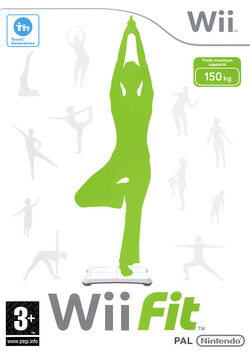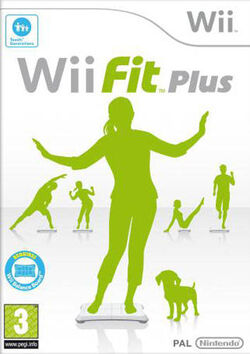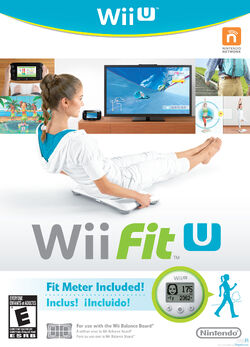The Wii series has become one of the best-selling video game franchises, with each game in the Wii series selling millions of copies. Wii Fit, within 18 months by June 2009, helped health games generate total revenues of $2 billion, most of which was grossed by Wii Fit's 18.22 million sales at the time.[1] The second largest subset of the franchise (after the Wii Sports series) is the Wii Fit sub-series.[2] The games and the total sales for the Wii Fit series are reported bellow:
Wii Fit[]
- See main article: Wii Fit
Wii Fit is the first game in the Wii Fit series. The game is perhaps Nintendo's most successful video game of all time, generating a revenue of $1.26 billion.
Wii Fit requires the use of the Wii Balance Board, a platform peripheral that the player stands upon during play. The Wii Balance Board is capable of measuring a person's weight, but is also able to detect the person's center of balance, a feature heavily utilized in the game.
Wii Fit contains more than 40 activities designed to engage the player in physical exercise, which consist of yoga poses, strength training, aerobics, and balance games. Most activities generally focus on maintaining center of balance and improving posture.
Release dates[]
- Japan: December 1, 2007
- Europe: April 25, 2008
- Australia: May 8, 2008
- North America: May 21, 2008
Gallery[]
Wii Fit Plus[]
- See main article: Wii Fit Plus
Wii Fit Plus is an enhanced version of Wii Fit. In addition to the original Wii Fit activities and options, Wii Fit Plus incorporates fifteen new balance and aerobics games (referred to as "Training Plus") and six new strength training and yoga activities New features include a calorie burning counter, the ability for users to create custom fitness regimens or choose from a number of specialized routines based on specific objectives and available time, as well as having the option to create profiles for pets and babies. Users are also able to navigate more quickly between exercises.
Release dates[]
- Japan: October 1, 2009
- North America: October 4, 2009
- Australia: October 15, 2009
- Europe: October 30, 2009
Gallery[]
Wii Fit U[]
- See main article: Wii Fit U
Like its predecessors Wii Fit and Wii Fit Plus, Wii Fit U focuses on engaging the player in physical activities, including yoga and strength training, through use of the Wii Balance Board, a platform peripheral upon which the player stands during play that measures both the player's weight and center of balance. Wii Fit U introduces activities that incorporate the Wii U GamePad into their gameplay, as well as activities that were featured in the previous games. Existing Wii Fit and Wii Fit Plus owners can transfer all their save data and records into Wii Fit U.
All retail copies of Wii Fit U are bundled with an activity meter, called the Fit Meter, which is carried while jogging or otherwise moving about the day. When the Fit Meter is placed near the Wii U GamePad, its data will be automatically uploaded via Infrared and saved to the Wii U. The Fit Meter is also sold separately.
Release dates[]
Nintendo eShop[]
- Japan, Europe and North America: November 1, 2013
- Australia: November 2, 2013
Retail[]
- Australia: December 7, 2013
- Europe: December 13, 2013
- North America: January 10, 2014
- Japan: February 1, 2014
Gallery[]
Game modes[]
Yoga and strength training[]
The yoga and strength training activities in the Wii Fit series provide the player with an on-screen personal trainer, who offers direction and evaluation. While standing or otherwise leaning on the Wii Balance Board, the player is instructed to perform the activity by precisely imitating the trainer's actions. In yoga, the player holds a particular pose or series of poses for a duration of time; while in strength training the player performs a set number of repetitions of the exercise selected. During these sessions, the player is shown a visual indication of his or her Center of Balance, represented as a red dot. The trainer advises the player to maintain the Center of Balance throughout the activity, requesting that it not move outside a particular threshold (usually indicated as a yellow circle). When the activity ends, the player is scored based on how well the player kept his or her balance during the session: points are deducted if the player's body haphazardly swayed or shook at any point.
Aerobics and balance games[]
The two other major categories in the Wii Fit series are aerobics and balance Games, consist of 18 mini-game activities that feature Miis as playable characters. Aerobics focus on activities that require more vigorous movement, and are divided into three distinct types, which are hula hooping, step aerobics, and jogging.
See also[]
References[]
| Wii Sports - Wii Sports Resort - Wii Sports Club - Switch Sports Wii Fit series Wii Fit - Wii Fit Plus - Wii Fit U
|
| Wii Play - Wii Play: Motion |
| Wii Party - Wii Party U |
Others Wii Chess - Wii Music - Wii Karaoke U |




















